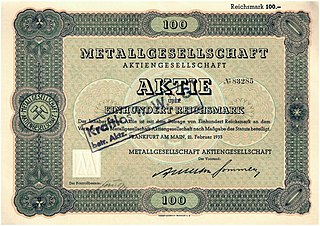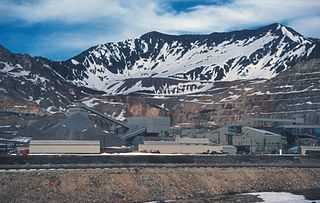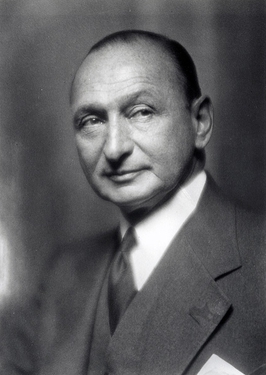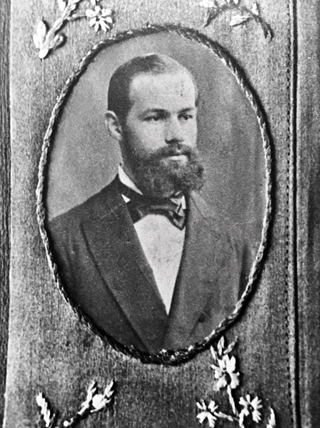The Cyprus Mines Corporation was an early twentieth century American mining company based in Cyprus. In 1914, Charles G. Gunther began prospecting in the Skouriotissa area after reading in ancient books that the island was rich in copper and noticing promising ancient Roman slag heaps in the area. The company was established in 1916 by Colonel Seeley W. Mudd, his son, Harvey Seeley Mudd, and mining engineer/business partner, Philip Wiseman, whose family, along with the Mudds, were the primary owners of Cyprus Mines until the early 1970s when it was sold to Amoco.

Metallgesellschaft AG was formerly one of Germany's largest industrial conglomerates based in Frankfurt. It had over 20,000 employees and revenues in excess of 10 billion US dollars. It had over 250 subsidiaries specializing in mining, specialty chemicals (Chemetall), commodity trading, financial services, and engineering (Lurgi). Henry Merton & Company, Ltd was previously a branch of the Metallgesellschaft.

Moritz (Mauricio) Hochschild was a leading mining industry businessman in the first half of the twentieth century. Along with Simón Iturri Patiño and Carlos Víctor Aramayo, he was one of the three so-called Bolivian tin barons. Additionally, he saved thousands of Jews during the Holocaust by facilitating their legal admission to Bolivia.

Centerra Gold Inc. is a Canadian mining company that owns and operates the Mount Milligan copper-gold mine in British Columbia, Canada, and the Öksüt gold mine in Turkey. Through its Thompson Creek Metals subsidiary company, it also owns the Endako and Thompson Creek molybdenum mines in British Columbia and Idaho, respectively, though they have been inactive since Centerra's acquisition. The company formerly owned and operated the Kumtor Gold Mine in the Kyrgyz Republic and the Boroo Gold Mine in Mongolia. Headquartered in Toronto, Centerra Gold is a public company with shares traded on the Toronto Stock Exchange and New York Stock Exchange.

Wilhelm Ralph Merton was a prominent and influential German entrepreneur, social democrat, and philanthropist. Among his most notable accomplishments, he was a founder of the University of Frankfurt and Metallgesellschaft AG, which became the largest non-ferrous mining company in the world and the second largest company in Germany.

The Climax mine, located in Climax, Colorado, United States, is a major molybdenum mine in Lake and Summit counties, Colorado. Shipments from the mine began in 1915. At its highest output, the Climax mine was the largest molybdenum mine in the world, and for many years it supplied three quarters of the world's supply of molybdenum.

Thompson Creek Metals Company Inc. was a full cycle mining company with acquisition, exploration, development, and operation in North America. The corporate office was located in Denver, Colorado. The company primarily produced copper, gold, and molybdenum. Over its history, the Company evolved from being a major primary molybdenum producer to becoming a copper and gold mining company with the construction and development of the Mount Milligan mine and concentrator in British Columbia, Canada. Mount Milligan was Thompson Creek Metals principal operation and the company owned 100% of this property. The company also owned 100% of its Thompson Creek Mine in Idaho. Thompson Creek Metals owned 75% joint venture interest in two other properties, including its Endako Mine in British Columbia, and its Langeloth Metallurgical Facility (roaster) in Pennsylvania. Thompson Creek Metals had additional development projects, including the Berg property in British Columbia.

The Mineral Park mine is a large open pit copper mine located in the Cerbat Mountains 14 miles northwest of Kingman, Arizona, in the southwestern United States. A 2013 report said that Mineral Park has an estimated reserves of 389 million tonnes of ore grading 0.14% copper and 31 million oz of silver.

The Cerro Verde mine is a very large copper mine located about 20 miles southwest of Arequipa, in southwestern Peru. Cerro Verde represents one of the largest copper reserves in Peru and in the world, having estimated reserves of 4.63 billion tonnes of ore grading 0.4% copper and 113.2 million oz of silver.
The Rhodesian Selection Trust (RST) was a mining Corporation which produced copper from the Copperbelt region of Northern Rhodesia, now Zambia.
Berthold Hochschild was a mining magnate, a founder of the American Metal Company, and a philanthropist.
Harold K. Hochschild was the president of the American Metal Company, a conservationist, a philanthropist, and the founder of the Adirondack Museum.
Walter Hochschild was an American industrialist, having spent 63 years as an executive with the American Metal Company, founded by his father, Berthold Hochschild. He became president of the company in 1950 and chairman and chief executive officer in 1957. He served as a trustee of the Museum of the City of New York for thirty years, and as a lifelong senior trustee of the United States Council of the International Chamber of Commerce. He was a member of the Council on Foreign Relations since 1947.

Molybdenum mining in the United States produced 65,500 metric tons of molybdenum in 2014, worth US$1.8 billion. The US was the world's second-largest molybdenum producer, after China, and provided 25% of the world's supply of molybdenum.

John Langeloth Loeb Sr. was an American investor and executive who served as president of Loeb, Rhoades & Company.

Carl Morris Loeb was a German-born American businessman who served as the president of the American Metal Company and the founder of Carl M. Loeb & Co, which became Loeb, Rhoades & Co. in 1938.

Zachary Hochschild was a German businessman, metal trader, and co-founder of Metallgesellschaft AG.

Cyprus Amax Minerals was a major US-based mining company formed in 1993 through the merger of AMAX with the Cyprus Minerals Company. It was one of the world's largest producers of Molybdenum and Lithium and a leading producer of copper and coal. It also produced iron ore and gold. It was acquired by the Phelps Dodge Corporation in 1999.
Sali Hochschild was a German-born Chilean businessman, the founder of Compania Minera y Comercial Sali Hochschild S.A., once one of the largest mining and mineral processing companies in Chile.












